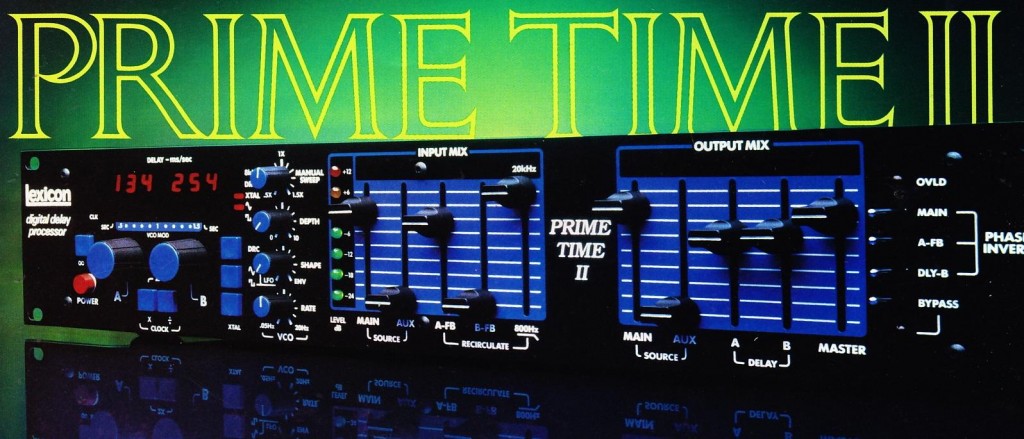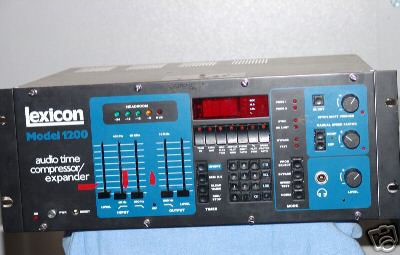![]() Download twenty-one pages of original Lexicon catalogs and sales materials from the mid 1980s.
Download twenty-one pages of original Lexicon catalogs and sales materials from the mid 1980s.
DOWNLOAD: LexiconProcessors1980s
Full details, photos, and specs on: Lexicon Model 97 Super Prime Time programmable digital delay; Prime Time II; PCM-42 delay unit; PCM-70 effects processor; 224-X Digital Reverb; plus a period price list and sales letter.
![]()

![]()
![]()
![]() It’s hard to remember just how important these devices were back in the 80s and early 90s, before the advent of DAWs (e.g. Pro Tools) and the audio-processing plug-in effects that accompanied the DAW. Sure, Lexicon digital reverb may not ‘really’ sound like the sound of a ‘real space,’ but it sure did sound like the sound of a Hit Record for a good long while. And if you wanted That Sound, the only way to get it was with one of these devices. There is still some demand for these devices (PCM-42s still go for around $1000 used), likely due to older engineers’ familiarity with these devices, as well as their still-relevant live sound and instrument-rig applications. Interesting to read these specs and see that, at best, these were 16k bandwidth devices. Who would dream of setting up a new Pro Tools session at 32K sampling rate these days?
It’s hard to remember just how important these devices were back in the 80s and early 90s, before the advent of DAWs (e.g. Pro Tools) and the audio-processing plug-in effects that accompanied the DAW. Sure, Lexicon digital reverb may not ‘really’ sound like the sound of a ‘real space,’ but it sure did sound like the sound of a Hit Record for a good long while. And if you wanted That Sound, the only way to get it was with one of these devices. There is still some demand for these devices (PCM-42s still go for around $1000 used), likely due to older engineers’ familiarity with these devices, as well as their still-relevant live sound and instrument-rig applications. Interesting to read these specs and see that, at best, these were 16k bandwidth devices. Who would dream of setting up a new Pro Tools session at 32K sampling rate these days?
Unfortunately I could not find any paper work on the most expensive item on the pricelist – the Lexicon 1200CMS stereo Digital Time Compressor/Expander.
This was a truly significant, cultish device. You can occasionally find them on eBay for around $200. Cost new in 1985? $15,995 for a stereo unit. In today’s money, that’s thirty-two thousand ($32,000) d0llars for a device that could (at 32k) pitch-shift a stereo program a semitone or so.
Who in their right mind would pay this money for this kind of functionality? Broadcasters, primarily. If you spend any time working in television post-production, you will still hear older producers and creative directors say “Lexicon it” to the sound engineer. Now, when they say this, they are not telling the mixer to put a shit load of echo or reverb on the audio. In the post-production audio world, “Lexicon-it” was an imperative to time-shift material. As-in, “Hey, johnny read that tag line a little slow. Can you Lexicon it, Joe?” The vogue for these devices in Broadcast really took off when put-upon ad-agency types realized that you now could make a 32-second commercial, and then speed the spot up to play back in 30 seconds time whilst ‘Lexicon-ing’ the audio program back to regular pitch. At the end of the day, the TV viewer can’t tell that anything is off, but you, Mr Crafty Agency dude, have managed to cram thirty-two seconds of your boss’s and clients’ revisions into a a thirty second commercial. You are now a genius. This is the stuff on which vacation homes are made.
Of course, music-recording engineers also used these things daily to fix pitch-y vocals and what not, but that’s a story for a different day…

3 replies on “Lexicon Digital Audio Processors of the 1980s”
I remember back in the early ’90s, CBS 60 Minutes decided they were going to do an “exposure piece” on the 2400, the replacement for the 1200CS. They were interviewing Ron Noonan, the President of Lex at the time and were attempting to position the product as an “evil type of device” that altered the directors intent by making movies go faster so that broadcasters could fill in an extra commercial or two. In typical fashion the interviewer was attempting to get Ron to squirm in his chair while being berated in the polite style of 60 Minutes. Ron was un-seatable however. He was ready with the sales figures that showed CBS was in fact one of Lexicon’s best customers with purchases of almost a dozen units in less than a year. That part never made it to air…
Wow; that story about Ron is great!
I’d really like to trade my two 1200s to anyone with a prime time or super prime time. They are both in excellent shape. I’m just an audio guy. don’t know how to work these things. Maybe I could learn…but that makes me sweat. HA!